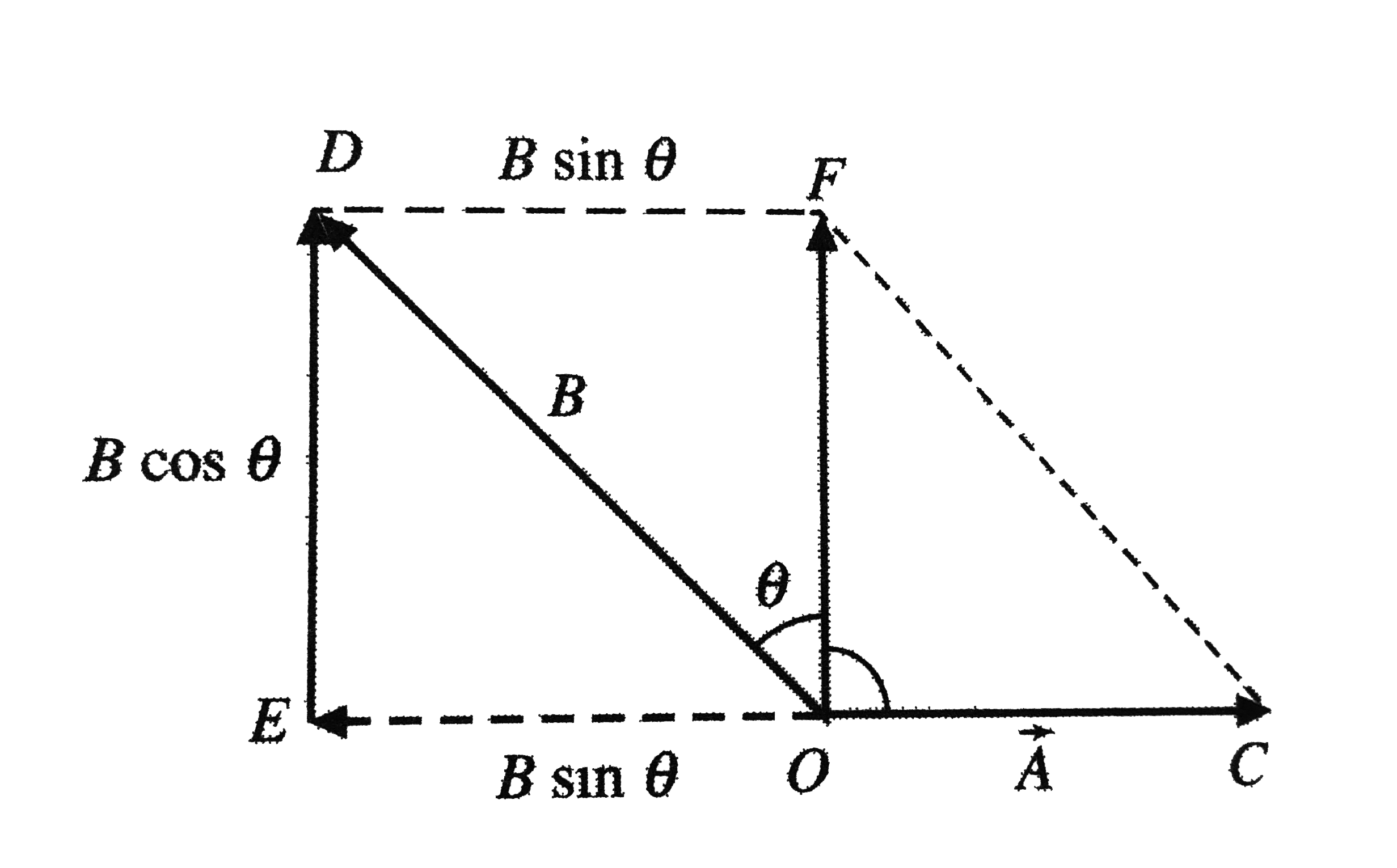Resultant of two vectors →Aand→B is of magnitude P, If →B is reversed, then resultant is of magnitude Q. What is the value of P2+Q2 ?
2(A2+B2)
2(A2−B2)
A2−B2
A2+B2
The correct Answer is:A
To solve the problem, we need to find the value of P2+Q2 based on the given conditions about the vectors →A and →B.
1. Define the Vectors: Let the magnitudes of the vectors be A and B, and let θ be the angle between them.
2. Resultant Magnitude when →B is not reversed: The magnitude of the resultant vector →R when →B is not reversed is given by:
P=√A2+B2+2ABcosθ
Squaring both sides, we have:
P2=A2+B2+2ABcosθ(Equation 1)
3. Resultant Magnitude when →B is reversed: When →B is reversed, the angle between →A and →B becomes 180∘+θ. The magnitude of the resultant vector Q is given by:
Q=√A2+B2+2ABcos(180∘+θ)
Since cos(180∘+θ)=−cosθ, we can rewrite this as:
Q=√A2+B2−2ABcosθ
Squaring both sides, we have:
Q2=A2+B2−2ABcosθ(Equation 2)
4. Add the Two Equations: Now, we add Equation 1 and Equation 2:
P2+Q2=(A2+B2+2ABcosθ)+(A2+B2−2ABcosθ)
The 2ABcosθ terms cancel out:
P2+Q2=2A2+2B2
Simplifying this gives:
P2+Q2=2(A2+B2)
Final Result:
Thus, the value of P2+Q2 is:
P2+Q2=2(A2+B2)
P=√A2+B2+2ABcosθ
Squaring both sides, we have:
P2=A2+B2+2ABcosθ(Equation 1)
Q=√A2+B2+2ABcos(180∘+θ)
Since cos(180∘+θ)=−cosθ, we can rewrite this as:
Q=√A2+B2−2ABcosθ
Squaring both sides, we have:
Q2=A2+B2−2ABcosθ(Equation 2)
P2+Q2=(A2+B2+2ABcosθ)+(A2+B2−2ABcosθ)
The 2ABcosθ terms cancel out:
P2+Q2=2A2+2B2
Simplifying this gives:
P2+Q2=2(A2+B2)
Thus, the value of P2+Q2 is:
P2+Q2=2(A2+B2)
Topper's Solved these Questions
- BOOK - VMC MODULES ENGLISHCHAPTER - JEE MAIN REVISION TEST - 18EXERCISE - PHYSICS - SECTION 25videos
JEE MAIN REVISION TEST - 18
- BOOK - VMC MODULES ENGLISHCHAPTER - JEE MAIN REVISION TEST - 13EXERCISE - PHYSICS (SECTION 2)5videos
JEE MAIN REVISION TEST - 13
- BOOK - VMC MODULES ENGLISHCHAPTER - JEE MAIN REVISION TEST - 19EXERCISE - PHYSICS25videos
JEE MAIN REVISION TEST - 19
Similar Questions
The resultant of two vectors →A and →B is perpendicular to the vector →A and its magnitude is equal to half of the magnitude of the vector →B. Find out the angles between →A and →B.
 .View Solution
.View SolutionMagnitude of resultant of two vectors →P and →Q is equal to magnitude of →P . Find the angle between →Q and resultant of →2P and →Q .
View SolutionThe resultant of two vectors →P and →Q is →R. If →Q is doubled then the new resultant vector is perpendicular to →P. Then magnitude of →R is :-
View SolutionTwo vectors →A and →B are such that →A+→B=→A−→B. Then
View SolutionResultant of two vectors of magnitudes P and Q is of magnitude 'Q'. If the magnitude of →Q is doubled now the angle made by new resultant with →P is
View SolutionFind the magnitude of resultant vector →R of two vectors →aand→b of magnitude 7 and 4 unit respectively if angle between then is 51.3∘. (Given cos51.3∘=5/8)
View SolutionFind the angle between two vectors →aand→b with magnitudes 1 and 2 respectively and satisfying →a.→b.=1
View SolutionThe magnitudes of two vectors →P and →Q differ by 1. The magnitude of their resultant makes an angle of tan−1(3/4) with P. The angle between P and Q is
View SolutionTwo vectors →P and →Q are added, the magnitude of resultant is 15 units. If →Q is reversed and added to →P resultant has a magnitude √113 units. The resultant of →P and a vector perpendicular →P and equal in magnitude to→Q has a magnitude
View SolutionTwo vectors →Aand→B have equal magnitudes.If magnitude of (→A+→B) is equal to n times of the magnitude of (→A−→B) then the angle between →Aand→B is :-
View Solution

